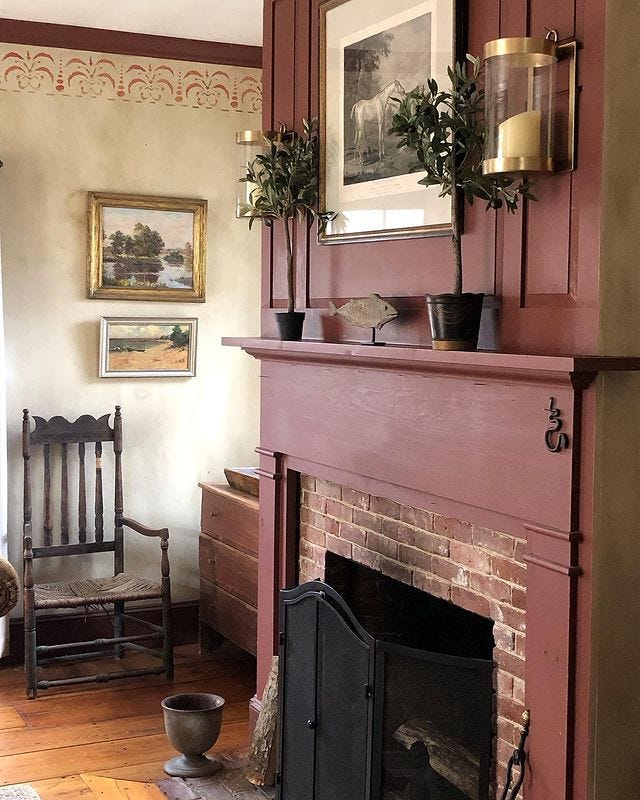The Wednesday Home Edit: At Home With Suzanne Charland, Early New England
Hello there!
I’m thrilled to be introducing a brand-new series, particularly with such a wonderful first guest. The Wednesday edition of the newsletter is dedicated to all things home and decor. ‘At Home With’ is a series of periodic interviews to feature beautiful homes and the people who decorate them. Think Style Profiles, but with houses!
One of my favorite home accounts on Instagram is Early New England by Suzanne Charland. If you haven’t seen Suzanne’s beautiful photos of her 1850 home in small-town New England, definitely check her feed out. I love the serene feeling evoked by her thoughtful use of antique pieces and the attention to historical details throughout her home.
I recently caught up with Suzanne about the process of renovating and restoring her home - keep reading for her tips on achieving the collected look and celebrating the beauty of old houses.
How long have you lived in your home? Had you owned a historic home previously?
We have lived in this house for 29 years. It looked very different inside when we bought it. It was decorated with pink wall-to-wall carpeting, silver foil wallpaper and mirrored walls among other things. I shudder to think about it 😂. Our first house was a new build, but for part of my childhood, I lived in a house that was built in the early 1900s. That house gave me an appreciation for the coziness and nooks and crannies of an old house. Of course, living in New England, old houses are the norm. In Massachusetts, 35% of the houses were built before 1900.
We've chatted a bit on Instagram about imagining the very first owners of our homes inhabiting the spaces we currently inhabit. How does this link to the past inform your approach to designing and arranging your spaces?
I’m a big believer in letting a house tell you what it wants. Living in an old house, I want to have respect for the age and integrity of the house and work with its architectural details. That was uppermost in my mind when we designed an addition to the house. The main goal was to make it blend with the rest of the house so that you wouldn’t recognize it as new by paying attention to the materials we used. We were careful to match the age of the house by purchasing antique wide board flooring and antique bricks for the fireplace. We used wooden divided light windows and had the window molding and trim custom made to match the original window molding in the front parlor. I think if you get all those little background details right, it goes a long way to creating spaces that look authentic to the house.
You display such beautiful collections of items throughout your home. What advice would you give someone striving to perfect the collected look?
The thing about antique collections is that you truly have to collect them. You can’t just go to the mall and buy an 18th clock. You have to wait for the antiques to find you. Collect what speaks to you, and it has a way of coming together perfectly. I think you will find that you gravitate toward complementary colors, textures and looks. Every piece then comes with a story of where and when you found it. These memories create a unique story for your home.
I like to mix antiques from different eras and countries. I’ll mix primitive painted American furniture with English pine and French ceramics. There is always something contemporary in the room, too, usually lighting or a vase.
To keep from overloading the house, I don’t display all my collections at once. I tend to rotate them often in connection with the seasons. For example, I’ll display redware, baskets, stone fruit and rich textiles like brocades in the fall. In summer, I’ll go with a lighter palette of white ironstone, glass fishing floats, brass and nautical paintings.
What has been your greatest challenge living in an older home? And what's your favorite thing about your home?
Older houses can be challenging in terms of the allotment of space with smaller enclosed rooms rather than larger open spaces. I personally prefer smaller, more intimate spaces, but it does make entertaining larger groups more challenging. After living here for a few years, we felt the need to add on a second living room space with the added bonus of second story attic space. That helped solve another old house challenge - lack of storage.
I was looking at your lovely IG feed while writing the questions and thinking how your photos inspire calm. Does the house inspire you to practice slow living and/or what overall impact does the interior have on your mood?
I wouldn’t say that living here has really inspired slow living for us. What I would say is I think an old house has a feeling of solidity and a presence just by virtue of the age materials and the length of time it’s settled into its place, and I like to think maybe the vibes of all those who lived here before. Decorating with antiques also lends to this feeling with their patina and evidence of use. All this leads to a mood in the house that to me feels enveloped and serene - almost a living thing in its own right. When I read this Mark Twain quote, it summed up how our house makes me feel. He said: “Our house was not insentient, it had heart and soul and eyes to see with … it was us and we were in its confidence and lived in the grace of its benedictions. We never came home from an absence that its face did not light up and speak out in eloquent welcome.”
All images appear courtesy of Suzanne Charland and may not be reproduced elsewhere.







